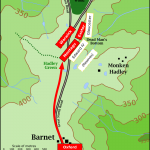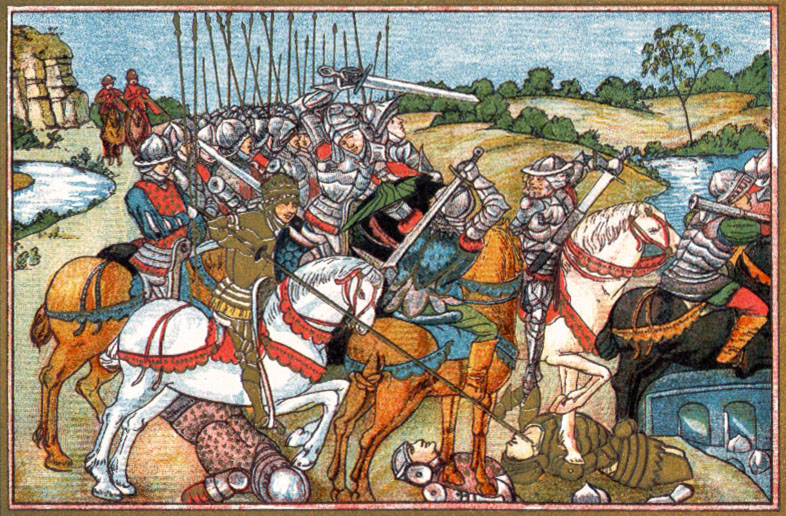The Battle of Barnet was fought on the 14th April 1471. This battle saw Edward IV attacking a Lancastrian force led by the Earl of Warwick. At Barnet, the weather was quite significant, as fighting led to confusion in misty conditions. The Earl of Oxford enjoyed success at the start of the battle. Some Lancastrian troops mistook Oxford’s return as a betrayal. Parts of the army fell into disarray. The Yorkist army pressed home this advantage and won the battle. Yorkist soldiers found the Earl of Warwick after the battle. They killed him.
Edward IV returns from exile and a resumption of the Wars of the Roses
Edward returned to England in March 1471. He landed at Ravenspur in Yorkshire. From here he marched to York where he was initially refused entry. Upon stating that he was merely there to assert his right to be the Duke of York he was admitted, for one night. From York, he moved south, careful to avoid Lancastrian areas of strength such as Lincolnshire. He gathered forces at Leicester and, probably to the surprise of Warwick, reconciled himself with his brother, George, Duke of Clarence.
The Yorkist army was unable to lure Warwick into a battle in the open at this point. They marched south toward London. Queen Margaret was in France gathering an army. This left London under the control of the Earl of Somerset and Earl of Devon along with the Archbishop of Canterbury. King Henry VI was resident in London at the time, though the rule was very much being done in his name now, rather than by him in person.
On 11th April, Edward and the Yorkist army entered London unopposed. Edward briefly reunited himself with his wife, saw his son for the first time and was hastily recrowned. He pardoned the Archbishop of Canterbury for his collusion with the Lancastrians but imprisoned him and Henry VI in the Tower of London for safekeeping.
Preparations for the Battle of Barnet
Edward IV led his army from London and made his way to Barnet on 13th April 1471.
The Warkworth Chronicle describes the departure of Edward IV and the Yorkist army to Barnet in brief terms:
“[On] Easter Eve all his host went towards Barnet, and carried King Harry with him, for he had understanding that the Earl of Warwick and the Duke of Exeter, Marquis Montagu, the Earl of Oxford, and many other knights, squires and commons, to the number of 20,000 were gathered together to fight against King Edward. But it happened that he and his host entered the town of Barnet before the Earl of Warwick and his. And so, the Earl of Warwick and his host lay outside the town all night, and each of them fired guns at the other.”
As the Warkworth Chronicle shows, King Edward IV was aware of the movements of the force that had been assembled by the Earl of Warwick. Edward had several objectives: to prevent this army from merging with that of Queen Margaret that was expected to land on the South Coast imminently; to prevent the City of London being besieged or ransacked; to retain control of King Henry and, to defeat and capture or kill the leaders of the opposing army.
With that in mind, Edward moved his force from London to meet the advancing away from the City of London. He set off for the town of Barnet, arriving there before it was taken and fortified by Warwick’s force.
Warwick’s army camped out in the open. The precise location of the battlefield is not known. English heritage surmises that the camp was on high ground to the west of Hadley. Below this high ground was a heath, marshy in places. To the east of the heath was a wood. Edward marched his men close to the Lancastrian camp.
As the two armies camped close to each other, they used artillery to harass, disrupt plans and ensure that the soldiers’ sleep was interrupted.
In the night, fog formed. Edward took advantage of this and ordered his men to silently move closer to the Lancastrian lines. In doing so, he made it hard for the Lancastrians to utilise the cannon that they had brought: Warwick had taken much from both his own armouries and from the stores at the Tower of London.
The Battle of Barnet
On the morning of 14th April, the two sides fought out the Battle of Barnet. Accounts show that the cannon did minimal damage, firing over the heads of the Yorkist line. The Yorkists then attacked the Lancastrians. The western flank of the Yorkist advance failed. The Earl of Oxford forced them back to Barnet. However, the fog now made it difficult for the pursuers to take full advantage. As the men of Oxford’s division routed the Yorkists and flanked them, they became disorientated. As Oxford’s troops returned to the battle, they were mistaken for enemies.

It appears that those within Lancastrian lines believed that the men of Oxford had switched sides during the heat of battle. This was not uncommon and the consequences of such an act were often decisive. Some accounts suggest that cries of treason and betrayal spread through the Lancastrian lines. Yorkist forces took the initiative. Oxford’s initial success on the flank turned into a disaster for the Lancastrians due to the misty conditions. The substantial Lancastrian force, which could have waited and fought once the Queen had arrived with reinforcements, was crushed. Edward IV had overcome his erstwhile ally the Earl of Warwick.

Death of the Earl of Warwick
Yorkist troops found the Earl of Warwick after the battle. Heavily laden in armour he had been unable to reach horses and make good an escape from the battlefield. Warwick was slain. The battle itself saw heavy losses for both sides. Five nobles on the Yorkist side are known to have perished at the Battle of Barnet. On the Lancastrian side, the number of nobles killed is unknown, though both Warwick and his brother were slain on the day.
Casualties at the Battle of Barnet
Overall casualty figures vary. In an account, by Wesels it is said that 1500 died on each side. Commynes suggests this figure for the Yorkists but more for the Lancastrian army. The Paston Letters suggest 1000 from each side. This is from estimated army sizes of 10000 Yorkists and 15000 Lancastrians. (Source of Casualty figures: Battlefield Trust).
Causes of the Wars of the Roses – Course of the War of the Roses – Events of the War of the Roses
Battles in the Wars of the Roses
First Battle of St. Albans – Battle of Blore Heath – Battle of Ludford Bridge – Battle of Northampton – Battle of Wakefield – Battle of Mortimer’s Cross – Second Battle of St. Albans Battle of Ferrybridge – Battle of Towton – Battle of Hedgeley Moor – Battle of Hexham – Battle of Edgecote Moor – Battle of Losecote Field – Battle of Barnet – Battle of Tewkesbury – Battle of Bosworth – Battle of Stoke Field
Documents, Maps and Evidence
The Rous Rolls – Paston Letters – Edward IV Roll
People and periods
British History – The Wars of the Roses – The Plantagenets – The Tudors – King Henry IV – King Henry V – King Henry VI – King Edward IV – King Edward V – King Richard III – King Henry VII – Margaret of Anjou
Schoolshistory – teaching resources for Key Stage 3, GCSE and A Level history



